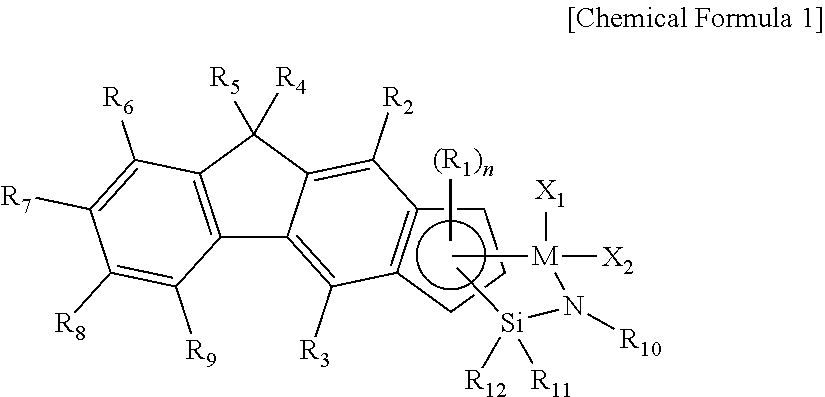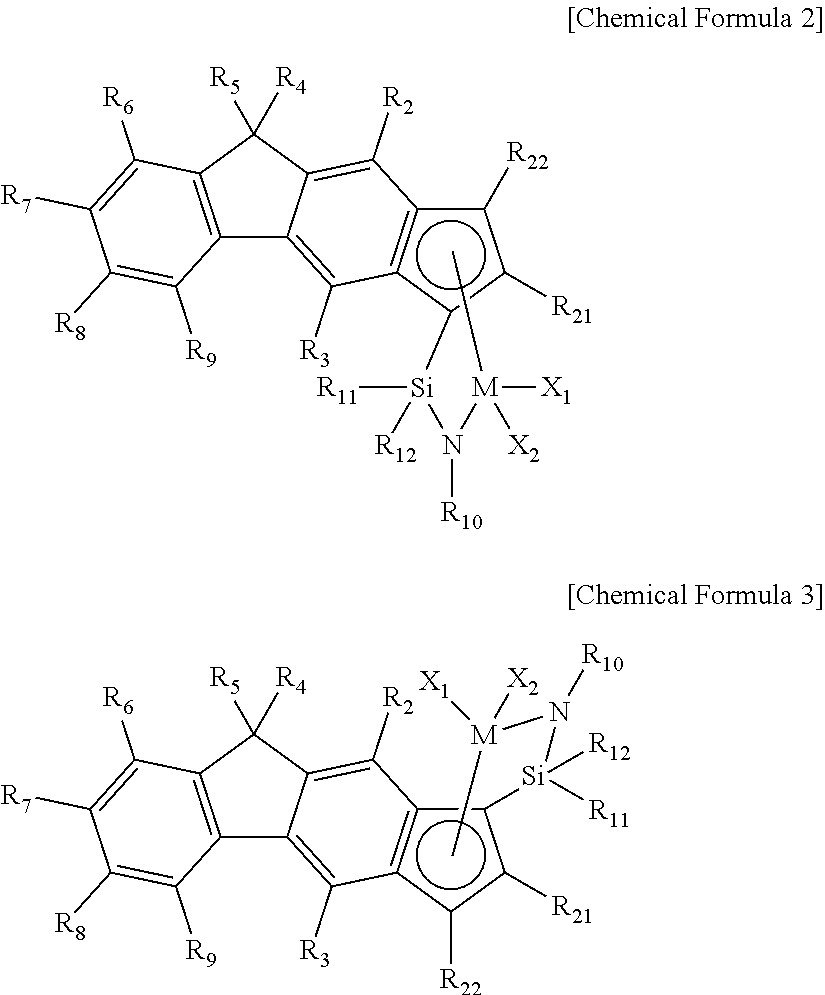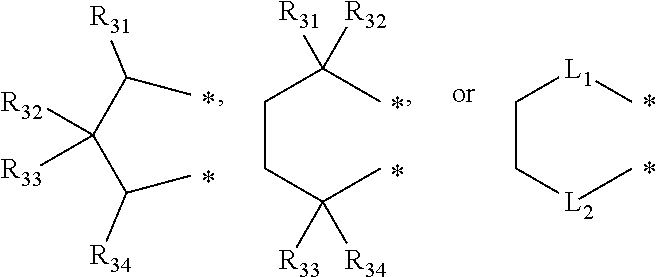Method of Preparing Ethylene-alpha-Olefin-Diene Copolymer
a technology of alpha-olefin-diene and copolymer, which is applied in the direction of group 4/14 element organic compounds, metallocenes, titanium organic compounds, etc., can solve the problems of difficult to obtain high-molecular weight polymers, uneven composition distribution, and broad molecular weight distribution of produced polymers, etc., to achieve high mooney viscosity, high conversion ratio, and high diene content
- Summary
- Abstract
- Description
- Claims
- Application Information
AI Technical Summary
Benefits of technology
Problems solved by technology
Method used
Image
Examples
preparation example 1
Preparation of Mixture of Complex 1 and Complex 2
[0073]
Synthesis of 9,9-dihexyl-9H-fluorene
[0074]A 2000 mL round flask was charged with 9H-fluorene (50 g, 300.1 mmol) and potassium t-butoxide (77.0 g, 721.9 mmol), and then 700 mL of DMSO was slowly injected thereto. 1-Bromohexane (119 g, 721.9 mmol) was slowly added thereto from a dropping funnel under nitrogen atmosphere. The mixture was stirred at room temperature for 24 hours, and the reaction was terminated by addition of 500 mL of distilled water. The organic layer collected by extraction with n-hexane was dried over magnesium sulfate, followed by removal of volatile materials, and then purified with n-hexane by using silica gel column chromatography, followed by drying and long-time storage at room temperature, to thereby obtain 90.0 g of 9,9-dihexyl-9H-fluorene (yield: 72.40%) as solid.
[0075]1H-NMR (500 MHz, CDCl3, ppm): δ 0.625-0.628 (m, 4H), 0.759-0.785 (m, 6H), 1.050-1.125 (m, 12H), 1.953-1.983 (t, 4H), 7.293-7.340 (m, 6H)...
preparation example 2
Preparation of Mixture of Complex 3 and Complex 4
[0086]
Synthesis of 9,9-dimethyl-9H-fluorene
[0087]A 2000 mL round flask was charged with 9H-fluorene (50 g, 300.1 mmol) and potassium t-butoxide (77.0 g, 721.9 mmol), and then 700 mL of DMSO was slowly injected thereto. Under nitrogen atmosphere, iodomethane (113.5 g, 800 mmol) was slowly dropped through a dropping funnel while the reactor temperature was maintained at 10° C. or lower. The mixture was stirred at room temperature for 24 hours, and the reaction was terminated by addition of 500 mL of distilled water. The organic layer collected by extraction with n-hexane was dried over magnesium sulfate, followed by removal of volatile materials, and then purified with n-hexane by using silica gel column chromatography tube, followed by drying, to thereby obtain 47.5 g of 9,9-dimethyl-9H-fluorene (yield: 81.50%) as white solid.
[0088]1H-NMR (500 MHz, CDCl3, ppm): δ 1.547 (s, 6H), 7.368-7.393 (t, 4H), 7.488-7.499 (d, 2H), 7.777-7.791 (d, ...
preparation example 3
Preparation of Mixture of Complex 5 and Complex 6
[0097]
Synthesis of N-cyclohexyl-1-(2,9,9-trimethyl-3,9-dihydrocyclopenta[b]fluoren-3-yl)-1,1-dimethylsilanamine and N-cyclohexyl-1-(2,9,9-trimethyl-1,9-dihydrocyclopenta[b]fluoren-1-yl)-1,1-dimethylsilanamine
[0098]In a 250 mL round flask, 2,9,9-trimethyl-3,9-dihydrocyclopenta[b]fluorene (7.5 g, 30.5 mmol) was dissolved in 300 mL of diethyl ether, and then the temperature was lowered to −78° C. Then, n-butyllithium (2.5M hexane solution, 12.4 mL) was slowly injected thereto, followed by stirring at room temperature for 12 hours. After the volatile materials were removed by vacuum, 200 mL of n-hexane was added to the mixture to lower the reactor temperature to −78° C., followed by addition of dichlorodimethylsilane (11.8 g, 91.4 mmol). The temperature was again raised to room temperature, followed by stirring for 24 hours, and then salts were removed through filtering. Then, volatile materials were removed by vacuum. The product was aga...
PUM
| Property | Measurement | Unit |
|---|---|---|
| temperature | aaaaa | aaaaa |
| pressure | aaaaa | aaaaa |
| temperature | aaaaa | aaaaa |
Abstract
Description
Claims
Application Information
 Login to View More
Login to View More - R&D
- Intellectual Property
- Life Sciences
- Materials
- Tech Scout
- Unparalleled Data Quality
- Higher Quality Content
- 60% Fewer Hallucinations
Browse by: Latest US Patents, China's latest patents, Technical Efficacy Thesaurus, Application Domain, Technology Topic, Popular Technical Reports.
© 2025 PatSnap. All rights reserved.Legal|Privacy policy|Modern Slavery Act Transparency Statement|Sitemap|About US| Contact US: help@patsnap.com



